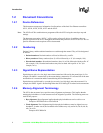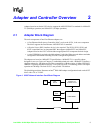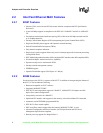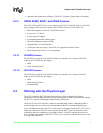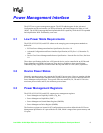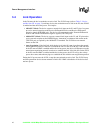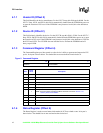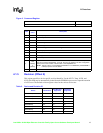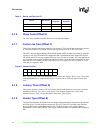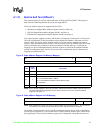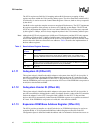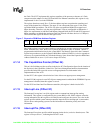
10 Intel 8255x 10/100 Mbps Ethernet Controller Family Open Source Software Developer Manual
Power Management Interface
3.4 Link Operation
In the D0 state, the device maintains an active link. The 82558 B-step (refer to Table 2, “Device
and Revision ID” on page 13) and later devices also maintain an active link in the D3 state if PME
is enabled and the device has power. This implies:
• 10BASE-T Mode: The device expects a normal clock input on the X1 and X2 pins. It expects
to receive normal reception on the Receive Differential Positive and Receive Differential
Negative signals (RDP/RDN pair). The device will not transmit on the Transmit Differential
Positive and Transmit Differential Negative signals (TDP/TDN pair).
• 100BASE-TX Mode: The device expects a normal clock input on the X1 and X2 pins and to
receive normal reception on the RDP/RDN pair. It transmits a continuous idle stream on the
TDP/TDN pair, as required by the 100BASE-TX standard. The 82558 does not transmit
frames on the link.
• Auto-Negotiation: If the link fails while the device is in the D1 state, it performs the normal
auto-negotiation protocol in order to re-establish the link. For the 82558 B-step, if the link fails
in the D3 state and PME is enabled and the device has power, the device will attempt to use the
normal auto-negotiation protocol in order to re-establish the link. If the link fails on the 82559
in the D3 state and PME is enabled and the device has power, the 82559 will go into a deep
power down state, rather than trying to re-establish the link with the auto-negotiation protocol.
During the D3 power state, the 82558 A-step does not maintain an active link. The 82558 B-step
and later generation devices do not maintain a link in D3 if PME is disabled or if the device does
not have power.



